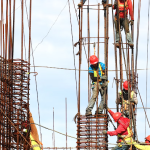In today’s construction landscape, the fusion of architecture and technology is reshaping the way buildings are designed, built, and experienced. This blog explores how advancements in technology are influencing architectural practices, revolutionizing construction processes, and enhancing the built environment.
1. Digital Design Tools:
Architects now have access to sophisticated digital design tools, such as Building Information Modeling (BIM) software and parametric modeling platforms, which enable them to create intricate designs with precision and efficiency. These tools allow architects to explore complex geometries, optimize building performance, and streamline collaboration with engineers and contractors.
2. Sustainable Design Solutions:
Technology plays a crucial role in sustainable design practices, allowing architects to analyze environmental impacts, optimize energy performance, and incorporate renewable materials into their projects. From passive design strategies to advanced energy modeling software, technology enables architects to create buildings that minimize resource consumption and environmental footprint.
3. Prefabrication and Modular Construction: Advancements in prefabrication and modular construction technologies are revolutionizing the way buildings are fabricated and assembled. Architects can leverage modular components and off-site fabrication techniques to expedite construction timelines, reduce waste, and improve quality control, leading to more efficient and cost-effective building delivery.
4. Smart Building Systems:
The rise of smart building systems, powered by Internet of Things (IoT) technology, is transforming the way buildings are operated and maintained. Architects can design integrated systems that monitor and optimize energy usage, enhance occupant comfort, and enable predictive maintenance, creating buildings that are responsive, efficient, and user-friendly.
5. Virtual Reality (VR) and Augmented Reality (AR):
VR and AR technologies are revolutionizing the architectural design process, allowing architects to visualize and experience their designs in immersive virtual environments. These tools enable clients and stakeholders to explore architectural spaces in real-time, providing valuable insights and feedback that inform design decisions and enhance project communication.
6. Adaptive Reuse and Historic Preservation:
Technology is enabling architects to breathe new life into existing buildings through adaptive reuse and historic preservation projects. Advanced scanning and modeling technologies allow architects to accurately document and assess historic structures, facilitating sensitive interventions and renovations that preserve architectural heritage while accommodating modern needs.
7. Continuous Innovation and Exploration:
The intersection of architecture and technology is a dynamic and evolving field, characterized by continuous innovation and exploration. Architects are embracing emerging technologies such as artificial intelligence, generative design, and 3D printing to push the boundaries of architectural expression, sustainability, and performance.
Conclusion:
The integration of architecture and technology is driving unprecedented innovation and transformation in the construction industry. By embracing digital design tools, sustainable practices, prefabrication techniques, smart building systems, and immersive technologies, architects are redefining the possibilities of the built environment and shaping a more sustainable, resilient, and connected future.


